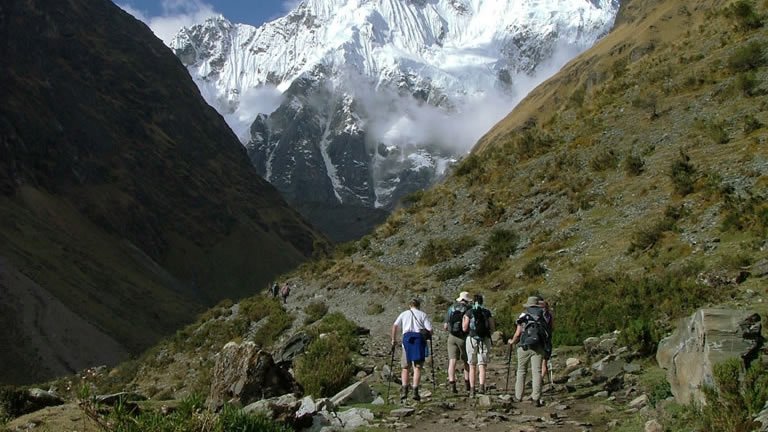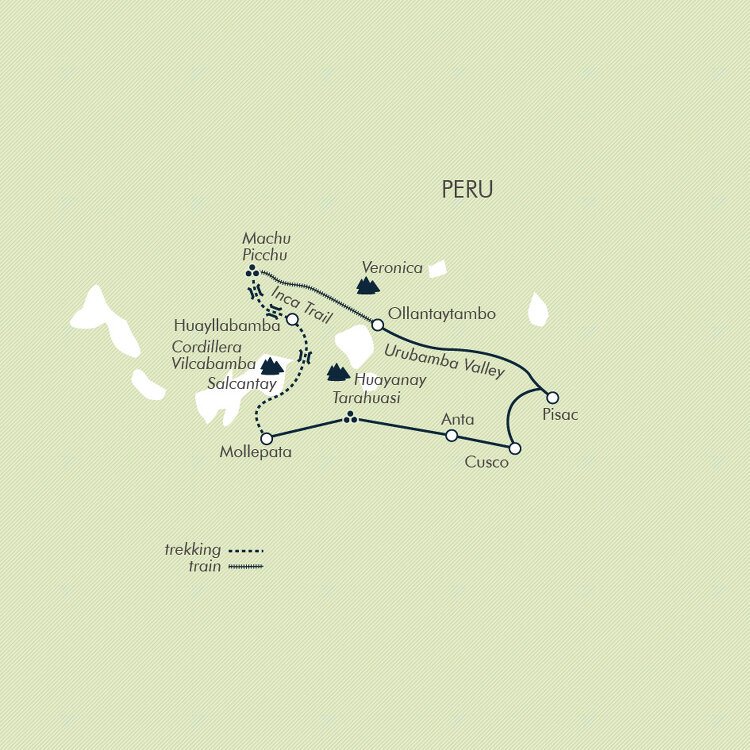Overview
Our classic Inca Trail trip is designed to give you more time to enjoy the trail by arriving to Machu Picchu in the afternoon for iconic photos and overnight in Aguas Calientes.
Itinerary
The trip starts in Cuzco. The Inca capital, small enough to be easily manageable, is among the most attractive cities in South America, with much of the centre comprising Colonial-era buildings with Inca foundations. It is also full of interesting museums, churches and pre-Columbian sites. We have a short walking tour of the city, including a visit to the Qoricancha Sun Temple. Take it easy upon arrival into Cuzco and drink plenty of water to allow your body time to acclimatise to the altitude (11,155ft/3,400m). There is a welcome briefing in the hotel lobby this evening. Stay: Mama Sara Hotel (or similar).
The hills above Cuzco are dotted with interesting Inca ruins. We drive to the highest, Tambomachay, and return on foot to Cuzco via Puca Pucara, Qenco and Sacsayhuaman: an easy walk to aid acclimatisation. An open-air picnic lunch is included during the hike near the spectacular ruins. Stay: Mama Sara Hotel (or similar) (B/L).
We have a free day in Cuzco to relax and further acclimatise before starting the tour. A range of optional activities and sightseeing excursions can be arranged, including visits to Inca and pre-Inca sites south of Cuzco, or walks in the hills surrounding the city but we recommend taking it relatively easy in preparation for the start of the trek tomorrow. Stay: Mamasara Hotel (or similar) (B).
A few hours' drive, via the interesting Inca remains of Tarawasi (optional), takes us to the hill town of Mollepata where we make a brief stop, before continuing to Marcocasa, where we start our trek. We trek from here to our campsite near Soraypampa (12,830ft/3,910m) where we spend our first night under canvas. The total driving time is approximately four hours, and the walk takes around five to six hours of uphill and steady climbing along well-made tracks. Stay: Soraypampa Camp (full-service camping) (B/L/D).
The morning begins, as all do on our Inca Trail trek, with a hot drink delivered to your tent. Start your day with an optional three-hour return walk to Humantay Lagoon to see the magnificent water mirror in the middle of the Andes. Return for an early lunch at the campsite of Soraypampa and then continue our ascent towards Salkantay, the "Savage Mountain" in local Quechua language, which soon dominates our view. We camp at around 14,435ft (4,400m) in the high grassy meadow of Ichu Pata, below the south face and glaciers of the impressive peak. Stay: Salkantay Camp (full-service camping) (B/L/D).
The high point of the trek, and the goal this morning, is the Inca Chiriasqa pass at almost 16,400ft (5,000m). Climbing more steeply now, we walk close to the spectacular glaciers and ice walls of Nevado Salkantay. Passing through Pampa Japonesa, basecamp for a Japanese mountaineering expedition, we finally top the pass and gain excellent 360-degree views. Inca Chirisaqa means ‘the Inca fell ill from cold' and the exposed situation makes it easy to see why.
Descending from the pass, we drop down into the upper reaches of a broad valley where Salkantay reappears in a new profile. After passing a huge ridge of terminal moraine, once the snout of the East Salcantay Glacier, the river suddenly straightens, canalised by the Incas centuries ago. We camp alongside the canal close to the hamlet of Pampa Cahuana (12,695ft/3,870m). Stay: Pampa Cahuana Camp (full-service camping) (B/L/D).
Setting off from camp this morning, we follow the canal, which soon drops into a steep-sided valley. The path follows the side of this valley all the way to Paucarcancha, an Inca watchtower which guarded the Pampa Cahuana valley. We have time to explore this small site before continuing to the village of Huayllabamba (10,170ft/3,100m) where we camp for the night. Stay: Huayllabamba Camp (full-service camping) (B/L/D).
Today we join the main Inca Trail, the iconic trek to Machu Picchu. Today's journey is both challenging and rewarding, marking the most demanding and best-known stretch of the trail. A slow and steady climb takes us through a cloud forest to the meadows of Llulluchapampa, then we summit Dead Woman's (Warmihuañusca) Pass, the highest point on the trek at 13,829ft (4,215m).
After a well-deserved round of high fives and photos at the summit, we begin our steep descent on original Inca steps to reach our campsite in the scenic valley of the Pacaymayu River (11,811ft/3,600m). Warm up in the dining tent with a hot, fresh meal followed by a well-deserved sleep under the Andean night sky. Stay: Pacaymayu Camp (full-service camping) (B/L/D).
After a hearty breakfast, we start the day with a climb, which takes us past the ruins of Runquracay and over the Runquracay Pass (12,894ft/3,930m), our second and final pass. From here, the Inca Trail becomes a clearly defined rolling path of flat boulders, providing access to sites only available to those on foot. One of the standout archeological sites we visit is Sayacmarca (11,893/3,625m), perched high above the green cloud forest. From here, we enjoy views of Salkantay mountain as we hike to our spectacular campsite on the ridge above the Inca site of Phuyupatamarca (12,073ft/3,680m), where we can enjoy the sunset and sunrise. Stay: Phuyupatamarca Camp (full-service camping) (B/L/D).
From Phuyupatamarca, we take the famous Inca steps: a 1. 2mi (2km) stone staircase that rapidly descends into an immense panorama, with the peaks of the Vilcabamba range above and the Vilcanota River far below. Reaching Wiñay Wayna, we have plenty of time to explore these beautiful ruins and eat lunch before continuing along a relatively flat section of the trail (by Inca standards, through cloud forest and wild orchids to finally reach Inti Punku (the Sun Gate).
From here, we get our first full sight of Machu Picchu, with the Huayna Picchu mountain rising behind… congratulations, you made it! Inti Punku is traditionally busy with photo-taking trekkers in the morning, so our late afternoon arrival affords us unobstructed views of the magnificent ruins. We also get a chance to snap some classic photos of Machu Picchu before we take the 30-minute bus down to the town of Aguas Calientes for a shower and comfortable bed for the night. Stay: Terraza de Luna (or similar) (B/L).
We start early to beat the day-trippers from Cuzco and reach the ruins as early as possible; buses return us up the winding road to the Machu Picchu entrance. During high season (May to October), there may be a bit of a wait. Machu Picchu is one of the architectural and engineering marvels of the ancient world and, what makes it all the more dramatic, is the staggering mountain backdrop.
The Spaniards never found it, the Incas left no records of it, and so it remained an enigma, a city lost for centuries in the jungle until it was rediscovered in 1911 by the American historian Hiram Bingham. Your guided tour highlights the history, culture, architecture and mysteries that Machu Picchu holds to this day. We catch an afternoon train back to Ollantaytambo (1hr 30min) where we stay for the night. Stay: Tunupa Lodge (or similar) (B).
We spend a day exploring the Sacred Valley of the Incas, visiting the Inca fortress ruins of Ollantaytambo and Pisac, which tower over the villages of the same name. We also have time to look around Pisac Market, known for handicrafts, before returning by road to Cuzco. Stay: Mama Sara Hotel (or similar) (B).
Today has been left free to relax or explore Cuzco further. There are several optional excursions available, which your tour leader can arrange for you. If you still have the energy, you could choose to mountain bike in the Sacred Valley taking a 18mi-22mi (30km-35km) ride through Moray, Maras and then down to Sacred Valley through ancient communities, farming fields and amazing Andean landscape. Alternatively, you could paddleboard on Lake Piuray near the town of Chinchero. Or, if feeling more subdued, take it easy and watch the world pass in Cuzco's Plaza de Armas. Stay: Mama Sara Hotel (or similar) (B).
Begin your return journey home after breakfast. But if you're not ready for the adventure to end, you can always book onto our Lake Titicaca extension, where you explore the sky-high waters by boat, visit an indigenous community and explore the pre‐Incan site of Sillustani. Alternatively, journey into the wilds on our Amazon Rainforest extension and explore lakes, rivers and jungle trails in search of the abundant wildlife that lives there (B).
Trip Inclusions
- Enjoy a remote full-service camping trek through the beautiful Vilcabamba range
- Connect the Salkantay Trail and classic Inca Trail for the ultimate inca trail trek
- Marvel at Mount Salkantay and its glaciers
- Experience two unique visits to Machu Picchu for photos and fully guided exploration
- Spend four nights in Cuzco, the old Inca capital
- Explore the fortresses and markets of the Sacred Valley
- 7 Classic nights (hotels), 6 Simple nights (full service camping)
- Seven days of walking with full porterage
- Travel by private minibus and by train
- Inca Trail permit required – early booking essential
- 22lb (10kg) personal baggage weight limit on trek
- All breakfasts, eight lunches and six dinners
- Tour leader throughout
- Arrival and departure transfers
- Full porterage throughout trek
- Exodus kitbag
- Inflatable sleeping mat while camping
- Itinerary and inclusions are subject to change
- Price is for land, cruise and internal flights as specified. Flights not specified are not included
- Altitude maximum: 16,275ft (4,960m); average: 11,645ft (3,550m)
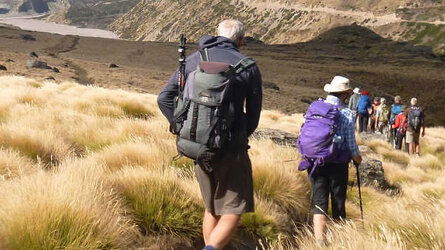
Hit the trails with Exodus - from challenging peaks to leisurely coastal and countryside walks. Read more
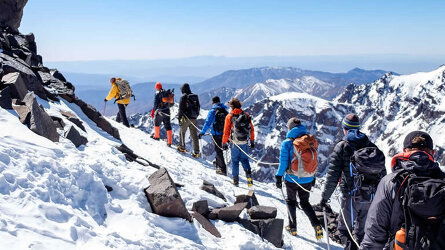
Exodus chooses their Leaders carefully. Professional, dedicated and are passionate about sharing their home countries. Read more
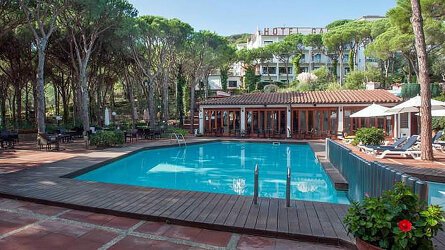
Wherever possible, Exodus chooses properties that are locally owned and that reflect the area you are visiting. Read more
Availability
A definite departure means minimum numbers have been reached for this departure to operate. Your Global Journeys Travel Advisor will check the availability of your departure date when you enquire. Additional savings may apply. We guarantee the lowest price in Australia. T&C’s apply.
Tour & cruises prices are per person. Prices shown have savings applied, are subject to availability and may be withdrawn at any time without notice. Pricing and trip details are correct at this point in time, however are subject to confirmation at the time of booking and are subject to change by Exodus. For cruise itineraries, cabin images are sourced from Exodus. These should be treated as indicative only. Cabin inclusions, upholsteries and room layout may differ to the image(s) shown depending on the ship selected and your sailing dates.
